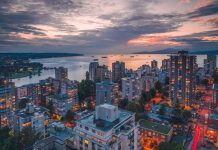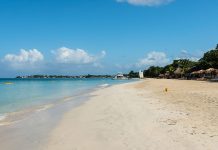Spatial patterns of tourism demand in provinces
Spatial distribution
Figure 5 illustrates the spatial distribution of tourism demand and flows between provinces in 2011 and 2018. In 2011, tourism demand was mainly distributed in China’s first-tier cities with Beijing and Shanghai and the border provinces from southwest to northwest, with Hainan, Yunnan, Tibet, and Xinjiang being the main tourism demand destinations 35.33% of tourism demand in the study area. In 2018, tourism demand showed a trend of migration to first-tier cities, with Yunnan, Tibet, Shanghai, Chongqing, and Guizhou accounting for 36.46% of the total tourism demand.
Figure 5
Spatial distribution of tourism demand and tourism demand flow: (a) tourism demand in 2011, and (e) is in 2018; (b–d) are the inter-provincial directional tourism demand flows in 2011, which are high-intensity flow, medium intensity flow, and low-intensity flow respectively, and (f–h) is in 2018.
From the spatial perspective of tourism flow, there are 930 tourism flows between provinces with a minimum Euclidean distance of 115 km, a maximum of 3600 km, and a median of 1286 km. Long-distance travel35 is a characteristic of tourism between domestic provinces. In 2011 the tourists’ origins were concentrated in eastern China, and there were two clusters of high-intensity tourism flows distributed from Beijing and the ring-Beijing area to Yunnan and Hainan; this phenomenon altered significantly in 2018, with high-intensity tourism flows concentrated on one cluster of tourism flows from eastern China to Yunnan Province. Medium-intensity tourism flows presented a complex network with a stochastic pattern in 2011; in 2018, the complexity of the tourism network decreased, with steady clusters of tourism flows originating from the eastern provinces to Xinjiang and Tibet, while the northeastern region became a complete exporter of tourists. Comparing the low-intensity tourism flows in 2011 and 2018, it can be attended that the overall origin and destination were practically completely connected, i.e., there were tourism flows from both border provinces and the central region. The central provinces also energetically export tourists to the peripheral provinces, diverting the overall tourism flow network to a more luxuriant state. In summary, we can catch that the domestic tourism network in China during the period of rapid economic development showed a remarkable complex pattern, with the origins of tourists consolidated in the densely populated and economically developed areas in the east and the destinations distributed in the first-tier cities, and remote areas in the central and western regions.
From 2011 to 2018, the northeastern provinces, Beijing-Tianjin-Hebei region (Beijing, Tianjin, Hebei), Yangtze River Delta region (Shanghai, Jiangsu, Zhejiang, Anhui), and Pearl River Delta region (Guangzhou) are stable tourist sources; the average value of tourism demand in each province rose from 642,515 to 1,529,387, an increase of 2.38 times (Fig. 6). Yunnan and Guizhou in the southwest and Gansu in the west grew at a much higher rate than the national average; Heilongjiang, Jilin, and Liaoning in the northeast grew at a much lower rate than the average; and Hainan in the south became the only province in the country where tourism demand decreased.
Figure 6
Spatial distribution of the ratio of tourism demand in 2018 to 2011.
Spatial dependency
The spatial distribution pattern of tourism demand shifted from medium to high clustering in 2011 and 2018, and the positive Moran’s I revealed the existence of high-value to high-value clustering or low-value to low-value clustering of tourism demand in the study area, and the spatial pattern and spatial dependence of tourism demand with evident clustering. The z-score increased by 177.58% during this period, and the p-value decreased by 88.96%. The probability of rejecting the null hypothesis increased from 90 to 95%. Thus, the spatial clustering trend of tourism demand strengthened.
The global Moran’s I identified the overall spatial dependence of tourism demand in each province within the study area, and Local spatial autocorrelation analysis was applied to uncover the local spatial association patterns. As can be seen from Fig. 7, significant stratification of tourism demand in 2011 and 2018 on a local spatial basis in China (absolute value of Z-score > 2.56, p-value < 0.01), consisting mainly of high-high value clusters (H–H) and low-low value clusters (L-L). In 2011, the H-H cluster was in Yunnan Province in southwestern China, the high values surrounded by low values cluster (H-L) appeared in Beijing, and the L-L cluster was in Heilongjiang Province in northeastern China. In 2018, the H-H cluster was still in Yunnan province, and the L-L clusters were distributed in Heilongjiang, Jilin, and Liaoning province, covering the whole northeastern region. From the perspective of spatial and temporal distribution, tourism demand formed a growth pole in southwestern China centered on Yunnan from 2011 to 2018, and tourism demand in Guizhou, adjacent to Yunnan, grew significantly and showed a spatial diffusion effect the region (Fig. 7). While in northeast China, the number of L-L clusters increased, and the provincial growth rate of tourism demand in low-value agglomeration was much lower than the national average during the study period. The existence of the H-L cluster in Beijing in 2011 and the disappearance of this cluster in 2018 indicated that Beijing had strong competitiveness in the region in the early stage, and the weakening polarization effect and the increasing diffusion effect diminished in the later stage when tourism demand was gradually distributed in a balanced manner in the Beijing-ring region. It suggested that tourism demand was more stable in China spatially in high-value clustering, and low-value clustering had increased, forming an increasingly stable high-value area in the southwest and low-value area in the northeast. Therefore, tourism demand in one province largely influences tourism demand in the adjacent provinces.
Figure 7
Local indicators of spatial association (LISA) for tourism demand in (a) 2011 and (b) 2018. The numerical marks on the maps represent P values, ** 5% level of significance (P < 0.05); *** 1% level of significance (P < 0.01).
Driving forces of tourism demand
Influencing factors of tourism demand
Figure 8 showed the explanatory power of the driving factors for tourism demand in 2011 vs. 2018. In 2011, The number of enterprises in the high-tech industry (0.5622) had the highest explanatory power, implying that GDP had a remarkably noticeable impact on tourism demand. Average daily hours of sunshine (0.4934), Urban park green space area (0.4928), Urban road area (0.4763), GDP per capita (0.4473), Railroad mileage (0.4229) had the same level of high explanatory power, which meant that these three drivers had the most noticeable impact on tourism demand. The number of museums (0.3932), value-added of tertiary industry (0.3892), Average wage of employees (0.3479), Total population (0.3429), Highway mileage (0.3024) were also significant drivers of tourism demand. Average daily temperature (0.2757) and altitude (0.2028) also influenced tourism demand. Green space coverage index (0.0616), A-class scenic spot index (0.0321). The nighttime light index (0.0062) had minimal explanatory power on tourism demand.
Figure 8
Power of determinant Q-statistic value for each driving factor in 2011 and 2018.
In 2018, the average daily hours of sunshine (0.5848) significantly affected tourism demand, expressing the strongest association with tourism demand: urban park green space area (0.4084), Average daily temperature (0.407). GDP per capita (0.4058) had a significant explanatory power on the spatial distribution of tourism demand. Urban road area (0.3924), Railroad mileage (0.3863), Average wage of employees (0.3753), The number of museums (0.37), Total population (0.3347), Highway mileage (0.3299), The number of enterprises in the high-tech industry (0.3191) were also significant factors influencing tourism demand. Tourism demand was limitedly influenced by the value-added of tertiary industry (0.2148), Altitude (0.1443). Green space coverage index (0.0198), A-class scenic spot index (0.0062). The nighttime light index (0.0054) had minimal effects on tourism demand.
Interaction of driving factors
One hundred twenty couple of interactions were generated yearly between the 16 factors in 2011 and 2018, the bulk of which had an enhancing effect on tourism demand, with the primary interaction type being nonlinear enhancement (55.83% in 2011 and 75.83% in 2018), followed by bi-variable enhancement (43.33% in 2011 and 23.33% in 2018). The explanatory power of the interaction on tourism demand was greater than that of the single factor with the maximum explanatory power.
As shown in Fig. 9a,c, in 2011, Average wage of employees-Average daily hours of sunshine (0.9935), Average wage of employees-Urban road area, GDP per capita-Railroad mileage, were two-factor non-linearly enhanced interactions with Q-statistic for the interactions greater than 0.99, showing a tourism demand with extreme explanatory power. Urban park green space area-Highway mileage, Average daily hours of sunshine-Highway mileage, Average daily hours of sunshine-Railroad mileage, Average wage of employees-Highway mileage, The number of museums-Average daily hours of sunshine, Average wage of employees-Urban park green space area, Urban park green space area-The number of museums were two-factor none-linearly enhanced interactions with interaction Q-statistic values greater than 0.98, a significant increase in the influence of synergy on tourism demand.
Figure 9
GeoDetector results: Power of determinants in interaction in (a) 2011 and (b) 2018; the difference of the impacts between two explanatory variables in (c) 2011 and (d) 2018.
In 2018 (Fig. 9b,d), Average daily temperature-Urban road area (0.9949), Urban park green space area-Average daily temperature, Average daily temperature-Highway mileage, Total population-Average daily temperature, GDP per capita-Highway mileage, Average wage of employees-Highway mileage, GDP per capita-Total population, The number of museums-Average daily temperature, were two-factor non-linearly augmented interaction patterns with interaction Q-statistic greater than 0.99, which almost wholly control the spatial distribution of tourism demand. Value-added of tertiary industry-Average daily temperature, GDP per capita-Average daily hours of sunshine, GDP per capita-Value added of tertiary industry, GDP per capita-Urban road area, GDP per capita-The number of museums, GDP per capita-Urban park green space area, were two-factor none-linearly enhanced and GDP per capita-Average daily hours of sunshine was two-factor enhanced with interaction Q-statistic values greater than 0.98.
The regional economic development and construction were the main drivers, followed by the size of the population and the base of tourism services, and again by the traffic conditions, with the influence of natural factors and tourism resources being minimal in 2011. Moreover, by 2018, the influence of tourism comfort factors began to rise, such as average daily hours of sunshine and average daily temperature, representing a significant increase. The level of social and personal economic development and transportation conditions also increased influence to 2011. It indicated that in the aftermath of the world economic crisis and during the economic recovery, the driving force affecting tourism demand is the city’s economy and level of development. However, after high economic growth, tourists have more requirements for the comfort of the experience during tourism, and the economy is no longer the main driving force directly affecting the spatial distribution of tourism demand.
Interaction mechanism
We filtered the five combinations with the maximum Q-statistic values from each of the 120 interaction combinations for 2011 and 2018, respectively, with an average explanatory power greater than 0.99 and two-factor nonlinear enhancement. It indicates that these combinations play a decisive role in the spatial distribution of tourism demand. The dominant factors to which each proxy variable belongs are also shown in Table 1. The ten combinations generated the interaction networks with the most explanatory power. The proxy variables and the determinants are mapped as nodes; the cumulative value of the Q statistics for the interactions between the node and other nodes determines the node’s size. The interactions between the factors are edges, and the Q-statistic values for interaction measured the weight of the edges. Different hierarchical interaction networks are visualized in Fig. 10 revealed the interactive mechanism.
Table 1 Top 5 Q statistic values of interactive detection in 2011 and 2018.Figure 10
Diagram of Interactive Network: the interactive network of proxy variables in 2011 (a) and 2018 (b); interactive network of dominants in (c) 2011 and (d) 2018; (e) global interactive network based on proxy variables; (f) global interactive network based on dominants.
From the perspective of the interaction of proxy variables, a strong triangular network community was formed in 2011 by average wages of employees—average daily hours of sunshine-highway mileage. In 2018, the interaction network shaped a significant polarization with the average daily temperature at the center, and average daily temperature and highway mileage formed a chain community. From the perspective of the interaction of dominants, Fig. 10c,d illustrate a substantial triangular network community formed by traffic conditions dominated by socio-economic development conditions and complemented by physical conditions in 2011. This community continued to persist in 2018, with the difference that the roles of physical and traffic conditions were switched.
Notably, the most significant interaction results in 2011 and 2018 were integrated to reveal the driving mechanisms impacting the distribution of tourism demand. Physical conditions existed at the core of the interaction network, mainly in the form of average daily temperature, which interacted extensively with other factors and was the central driver influencing the distribution of tourism demand, indicating that tourism comfort is the basis of the natural scenery tourism attraction. Socio-economic development followed closely behind in physical conditions, with the average wage of employees representing the general level of economic development in the region and the prosperity of the tertiary sector, characterizing the level of tourism services, as well as being the foundation for driving the city to be a tourist attraction. The importance of traffic conditions was uncovered in tourism accessibility and the compression of the time distance. The three formed a concrete network of interactions that influenced the spatial distribution of tourism demand.
Escape the ordinary and discover the extraordinary! From bustling cities to serene landscapes, every journey begins with a single step—let us guide yours. Enjoy curated itineraries, hidden gems, and hassle-free bookings designed for explorers at heart. Whether it's a weekend getaway or a globe-trotting adventure, your Next unforgettable experience is just a click away.









